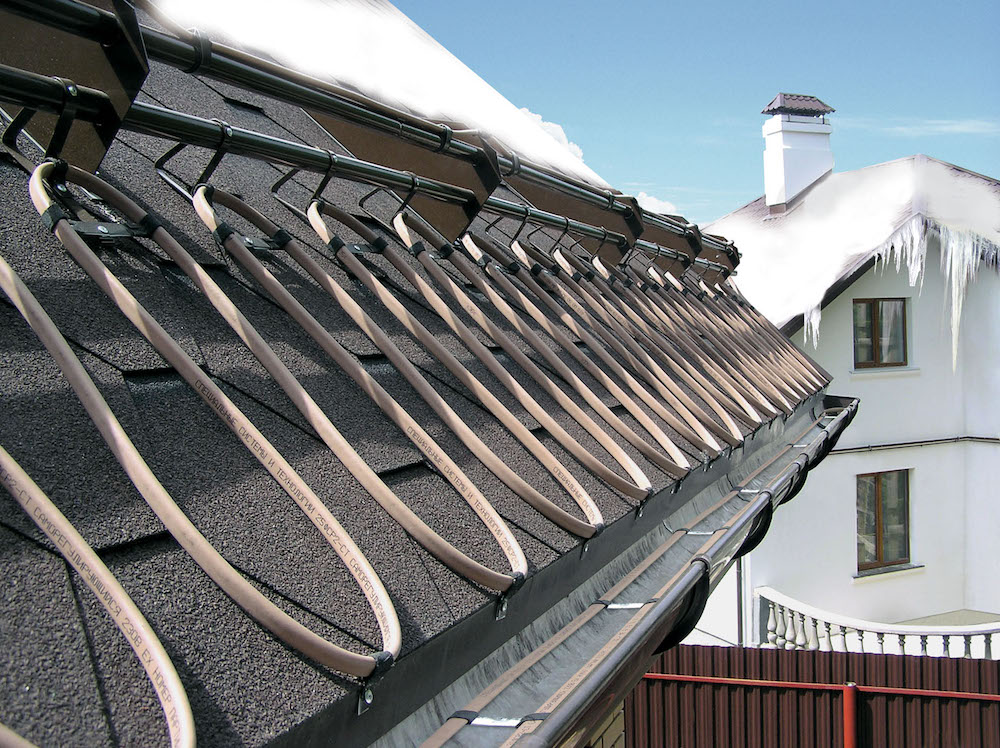We tell you in what cases it is necessary to install an electric roof heating system in a private house, what components it consists of, and how you can use a heating cable.
Ice on the roof practically does not harm the roofing covering, but it poses a very real danger to building structures and the inhabitants of the house. Icicles tear off gutters, and if they fall, they can damage underlying canopies and roofs, and finally injure people. However, not every roof grows meter-long icicles in winter. Why? Let’s explain now.
Why do icicles form?
Ice forms most intensively on a poorly designed or poorly constructed roof. The bottom line is that the “wrong” roof, closer to the ridge, is heated in winter by warm air from the rooms below. The snow in this zone melts, the water flows to the eaves, where the temperature is lower, and turns into ice. This happens, say, if, when installing the attic floor, they saved on insulation and forgot to provide for attic ventilation.
Another example is the inept execution of the attic roofing pie: the builders “forgot” about the under-roof ventilation gap, blocked it with lathing or incorrectly laid the hydro-windproof film, as a result of which the insulation got wet and lost its properties.
On a well-made roof, icicles form only as a result of specific weather conditions – repeated alternation of thaws and frosts, and the scale of the “disaster” is much smaller. Here it is quite possible to do without an electric heating system, but only if pedestrian paths are not laid directly under the eaves overhangs, recreation areas and parking lots are not built, and glass structures are not erected.

How does the de-icing system work?
The de-icing system consists of heating cables that are fixed on the roof, power and switching wires laid throughout the building, as well as control units and sensors responsible for the timely activation of heating.
Two main types of cable are used as heaters – constant power (from 10 to 30 W/m) and self-regulating. In turn, constant power cables come in two varieties – single-core and double-core. The first has a heating core made of a resistive nichrome alloy enclosed in polymer insulation and a metal shielding shell. On both sides of such a cable there are power ends that must be connected to the mains. A more modern two-core cable has a low-resistance conductor (copper, aluminum) running parallel to the resistive one. At the end of a section (piece) of cable, two conductors are connected and this unit is waterproofed with a special coupling. A two-core cable is approximately 30% more expensive than a single-core cable, but it is easier to install.
Self-regulating cables change heat output depending on environmental conditions and temperature. This prevents the cable from overheating and failing, which ensures high safety and reliability of the system. Such cables can be easily cut into sections of arbitrary length (up to several tens of meters) directly on site, which makes them convenient to use. The flat section ensures good contact with the heated surface, reducing heat loss.
Theoretically, you can control the system manually, turning it on when weather conditions favor the formation of icicles (that is, at near-zero temperatures). However, in practice, this is extremely inconvenient, and one cannot do without “smart” electronics – sensors for temperature and humidity, precipitation and water, and thermostats. In addition, an important and necessary component of the system is protective devices – automatic devices.

How to install an anti-icing system
As a rule, sections of the heating cable are laid out along the eaves and in the valley area in a snake 50-70 cm wide (depending on the length of the slope); In gutters and pipes, the cable is laid linearly, and in addition, it is mounted on snow retainers. The sections are fastened to the roofing using special clips. At the same time, many additional holes have to be made in the coating, which may further affect its durability. Therefore, the qualifications of the workers and the quality of the materials used, in particular roofing sealant, are very important.
Additional system features
Short sections of resistive cable can be used for local heating of building structures and components of engineering systems. For example, if you lay them inside the frame of a steel door, this will prevent the formation of ice in the vestibule area. Specialists from installation companies have made successful attempts to equip roller garage doors with electric heating , and many companies offer products for defrosting taps and valves, which will be useful to summer residents who missed the frost and did not drain the water from their individual water supply system in time. Finally, a powerful armored cable can be used in snow-melting systems on porch steps and open areas, where it is embedded in a concrete screed under the tiles.
Read more: What You Need to Protect Your Roof: 6 Points You Should Know



